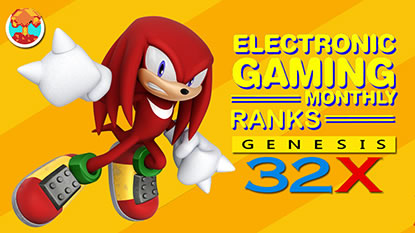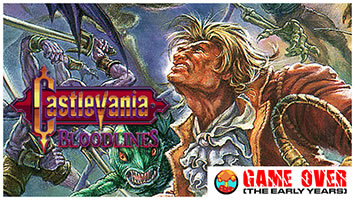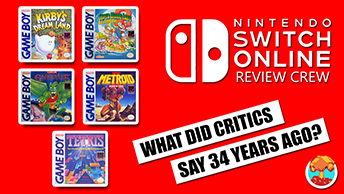- CLASSIC MAGAZINES
- REVIEW CREW
A show recapping what critics thought back
when classic games first came out! - NEXT GENERATION'S BEST & WORST
From the worst 1-star reviews to the best
5-stars can offer, this is Next Generation! - NINTENDO POWER (ARCHIVE)
Experience a variety of shows looking at the
often baffling history of Nintendo Power! - MAGAZINE RETROSPECTIVE
We're looking at the absolutely true history of
some of the most iconic game magazines ever! - SUPER PLAY'S TOP 600
The longest and most ambitious Super NES
countdown on the internet! - THEY SAID WHAT?
Debunking predictions and gossip found
in classic video game magazines! - NEXT GENERATION UNCOVERED
Cyril is back in this spin-off series, featuring the
cover critic review the art of Next Generation! - HARDCORE GAMER MAGAZING (PDF ISSUES)
Download all 36 issues of Hardcore Gamer
Magazine and relive the fun in PDF form!
- REVIEW CREW
- ELECTRONIC GAMING MONTHLY
- ELECTRONIC GAMING MONTHLY RANKS
From Mario to Sonic to Street Fighter, EGM
ranks classic game franchises and consoles! - ELECTRONIC GAMING MONTHLY BEST & WORST
Counting down EGM’s best and worst reviews
going year by year, from 1989 – 2009! - ELECTRONIC GAMING BEST & WORST AWARDS
11-part video series chronicling the ups and
downs of EGM’s Best & Worst Awards!
- ELECTRONIC GAMING MONTHLY RANKS
- GAME HISTORY
- GAME OVER: STORY BREAKDOWNS
Long-running series breaking down game
stories and analyzing their endings! - A BRIEF HISTORY OF GAMING w/ [NAME HERE]
Real history presented in a fun and pithy
format from a variety of game historians! - THE BLACK SHEEP
A series looking back at the black sheep
entries in popular game franchises! - INSTANT EXPERT
Everything you could possibly want to know
about a wide variety of gaming topics! - FREEZE FRAME
When something familiar happens in the games
industry, we're there to take a picture! - I'VE GOT YOUR NUMBER
Learn real video game history through a series
of number-themed episodes, starting at zero! - GREAT MOMENTS IN BAD ACTING
A joyous celebration of some of gaming's
absolute worst voice acting!
- GAME OVER: STORY BREAKDOWNS
- POPULAR SHOWS
- DG NEWS w/ LORNE RISELEY
Newsman Lorne Riseley hosts a regular
series looking at the hottest gaming news! - REVIEW REWIND
Cyril replays a game he reviewed 10+ years
ago to see if he got it right or wrong! - ON-RUNNING FEUDS
Defunct Games' longest-running show, with
editorials, observations and other fun oddities! - DEFUNCT GAMES QUIZ (ARCHIVE)
From online quizzes to game shows, we're
putting your video game knowledge to the test!- QUIZ: ONLINE PASS
Take a weekly quiz to see how well you know
the news and current gaming events! - QUIZ: KNOW THE GAME
One-on-one quiz show where contestants
find out if they actually know classic games! - QUIZ: THE LEADERBOARD
Can you guess the game based on the classic
review? Find out with The Leaderboard!
- QUIZ: ONLINE PASS
- DEFUNCT GAMES VS.
Cyril and the Defunct Games staff isn't afraid
to choose their favorite games and more! - CYRIL READS WORLDS OF POWER
Defunct Games recreates classic game
novelizations through the audio book format!
- DG NEWS w/ LORNE RISELEY
- COMEDY
- GAME EXPECTANCY
How long will your favorite hero live? We crunch
the numbers in this series about dying! - VIDEO GAME ADVICE
Famous game characters answer real personal
advice questions with a humorous slant! - FAKE GAMES: GUERILLA SCRAPBOOK
A long-running series about fake games and
the people who love them (covers included)! - WORST GAME EVER
A contest that attempts to create the worst
video game ever made, complete with covers! - LEVEL 1 STORIES
Literature based on the first stages of some
of your favorite classic video games! - THE COVER CRITIC
One of Defunct Games' earliest shows, Cover
Critic digs up some of the worst box art ever! - COMMERCIAL BREAK
Take a trip through some of the best and
worst video game advertisements of all time! - COMIC BOOK MODS
You've never seen comics like this before.
A curious mix of rewritten video game comics!
- GAME EXPECTANCY
- SERIES ARCHIVE
- NINTENDO SWITCH ONLINE ARCHIVE
A regularly-updated list of every Nintendo
Switch Online release, plus links to review! - PLAYSTATION PLUS CLASSIC ARCHIVE
A comprehensive list of every PlayStation
Plus classic release, including links! - RETRO-BIT PUBLISHING ARCHIVE
A regularly-updated list of every Retro-Bit
game released! - REVIEW MARATHONS w/ ADAM WALLACE
Join critic Adam Wallace as he takes us on a
classic review marathon with different themes!- DEFUNCT GAMES GOLF CLUB
Adam Wallace takes to the links to slice his way
through 72 classic golf game reviews! - 007 IN PIXELS
Adam Wallace takes on the world's greatest spy
as he reviews 15 weeks of James Bond games! - A SALUTE TO VAMPIRES
Adam Wallace is sinking his teeth into a series
covering Castlevania, BloodRayne and more! - CAPCOM'S CURSE
Adam Wallace is celebrating 13 days of Halloween
with a line-up of Capcom's scariest games! - THE FALL OF SUPERMAN
Adam Wallace is a man of steel for playing
some of the absolute worst Superman games! - THE 31 GAMES OF HALLOWEEN
Adam Wallace spends every day of October afraid
as he reviews some of the scariest games ever! - 12 WEEKS OF STAR TREK
Adam Wallace boldly goes where no critic has
gone before in this Star Trek marathon!
- DEFUNCT GAMES GOLF CLUB
- DAYS OF CHRISTMAS (ARCHIVE)
Annual holiday series with themed-episodes
that date all the way back to 2001!- 2015: 30 Ridiculous Retro Rumors
- 2014: 29 Magazines of Christmas
- 2013: 29 Questionable Power-Ups of Christmas
- 2012: 34 Theme Songs of Christmas
- 2011: 32 Game Endings of Christmas
- 2010: 31 Bonus Levels of Christmas
- 2009: 30 Genres of Christmas
- 2008: 29 Controls of Christmas
- 2007: 34 Cliches of Christmas
- 2006: 33 Consoles of Christmas
- 2005: 32 Articles of Christmas
- 2004: 31 Websites of Christmas
- 2003: 29 Issues of Christmas
- 2002: 28 Years of Christmas
- 2001: 33 Days of Christmas
- NINTENDO SWITCH ONLINE ARCHIVE
- REVIEW ARCHIVE
- FULL ARCHIVE
Violence in Gaming ... Thank God!

Hey buddy, if you kill yourself then who's going to play Vice City?
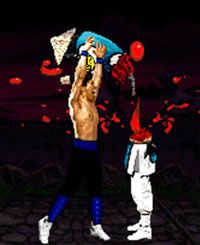
It's hard to believe that something like this is actually controversial!
The two games that led the way for the controversy were both amazingly mediocre games. The first, Mortal Kombat, used digitized graphics to present a one-on-one fighting game. Designed by Ed Boon and John Tobias, Mortal Kombat was a response to Street Fighter II. It featured multiple hidden moves and very similar design mechanics. What set it apart, however, were the moves one could make at the end of the game, called

I had an option, I could go with Dana Plato from Diff'rent Strokes or Dana Plato in softcore porn. I chose softcore porn!
The other game that put the industry in the national spotlight was Night Trap. Starring Diff'rent Strokes' Dana Plato, this was a horribly campy game with very limited game play that appeared on the Sega CD. I feel safe in saying that anyone who has played Night Trap would happily tell you what a steaming pile of manure the game actually is. If it weren't for the controversy stirred up by the hearings the game would have quickly and quietly flopped, but instead it became the leading game of the Sega CD, sometimes selling for double its suggested retail price. The game was actually created in 1986 by
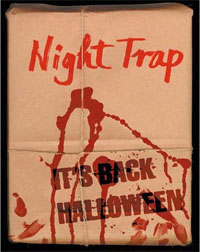
This is probably the least excited I have ever been about opening a package!
Two aspects tied Mortal Kombat and Night Trap directly to Sega, leading to them leading the defense in the joint hearings. First was the fact that Night Trap was published on the Sega CD. It would eventually be ported, for some insane
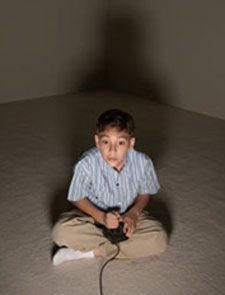
Hey kid, sometimes it's important for you to let go of your joystick!
I'll spare the reader the boring details of the hearings, and focus on a few of the highlights. There are probably few gamers today who remember Marilyn Droz, but at the time she was definitely the loud voice of protest. Think of her as the early nineties version of Jack Thompson or Lt. Colonel Dave Grossman. She appeared on Donahue, made public pleas for safer, friendlier games, and complained that little girls didn't have any video
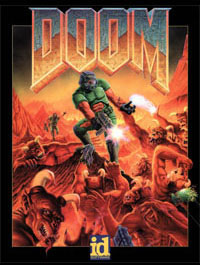
Despite the fact that it's a good fifteen years old, Doom still manages to get blamed for many of today's crimes!
The other two "honored guests" at the hearings worthy of particular note were Howard Lincoln from Nintendo and Bill White from Sega. Howard Lincoln played the Nintendo "image" to the hilt. He began by stating the level of concern that Nintendo has over entertainment content and mentioned many times their censoring of Mortal Kombat on the Super Nintendo. He mentioned the security chip of their console and its ability to keep harmful material off of their system. In all, he was an absolute and complete kiss-ass, and even managed to get polite treatment from Senator Joe Lieberman, the head of the hearings. Bill White, appearing after

Senator Lieberman (shown here without his patented Joe-Mentum) just looks like the kind of guy you would want to play a game with!
In the end, we ended up with the Interactive Digital Software Association (IDSA) and the Entertainment Software Ratings Board (ESRB). The ESRB utilized a voluntary ratings system that borrowed heavily from the voluntary ratings system used by movies. No game was required to be rated, but any game sold at retail was. It has become a self-regulating system that rates hundreds of games each
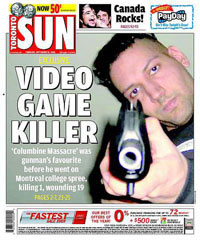
Just once I would like to see a tabloid run a picture like this with the caption: "Daytime Soap Opera Killer!"
When the hearings were repeated in 1999 after a storm of school violence in 1997 and 1998 that culminated with the Columbine Massacre, the software industry came out of it looking much better than they had previously. Doug Lowenstein, head of the IDSA, managed to come out of the hearings surprisingly clean. Senator Brownback has made it clear that he wanted these hearings to publicly humiliate entertainment executives, but Lowenstein refused to be baited. He used IDSA statistics, ESRB statistics, and offered a concise plan for the future. He
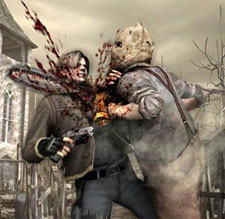
I don't care how graphic Grand Theft Auto is, for my money there is nothing more brutally violent than this scene from Resident Evil 4!
The battle between child safety and video games continues today, despite the influence of the ESRB and the IDSA. Controversies over the ratings of Oblivion and Grand Theft Auto: San Andreas have been extremely hard to miss. In both cases, the user's ability to access locked out content, or even just create their own content, has led to a game being re-rated at a higher level. San Andreas in particular had to re-edit the game in order to regain their "M" (Mature) rating, having been re-rated as "Adults Only." Some claimed

Manhunt 2, the Night Trap of the 21st Century!
Just in the past few weeks the game Manhunt 2 by Take Two Interactive has been classified as "AO" by the ESRB, and every game company and retailer imaginable is rushing to wash their hands of the title. It is, however, because of these two organizations that the game is allowed to exist at all. Due to the self-regulatory system and every company being answerable to every other company, it has been impossible to make any legal claims stick to the industry. Games are no more censored than movies or music, despite the efforts of many different parties to get them sanitized. Manhunt 2 might be modified to better fit with the role of the ESRB or it might stay the way it is and be sold through alternative channels, but the ESRB is doing its job: Heading off another hearing before it can happen. Without the industry having moved in the direction that it did, our days might be filled with Barbie Horse Adventures or even more Myst sequels. I can already hear Cyril crying out at the very thought of that possibility.



HOME |
CONTACT |
NOW HIRING |
WHAT IS DEFUNCT GAMES? |
NINTENDO SWITCH ONLINE |
RETRO-BIT PUBLISHING
Retro-Bit |
Switch Planet |
The Halcyon Show |
Same Name, Different Game |
Dragnix |
Press the Buttons
Game Zone Online | Hardcore Gamer | The Dreamcast Junkyard | Video Game Blogger
Dr Strife | Games For Lunch | Mondo Cool Cast | Boxed Pixels | Sega CD Universe | Gaming Trend
Game Zone Online | Hardcore Gamer | The Dreamcast Junkyard | Video Game Blogger
Dr Strife | Games For Lunch | Mondo Cool Cast | Boxed Pixels | Sega CD Universe | Gaming Trend
Copyright © 2001-2025 Defunct Games
All rights reserved. All trademarks are properties of their respective owners.
All rights reserved. All trademarks are properties of their respective owners.













